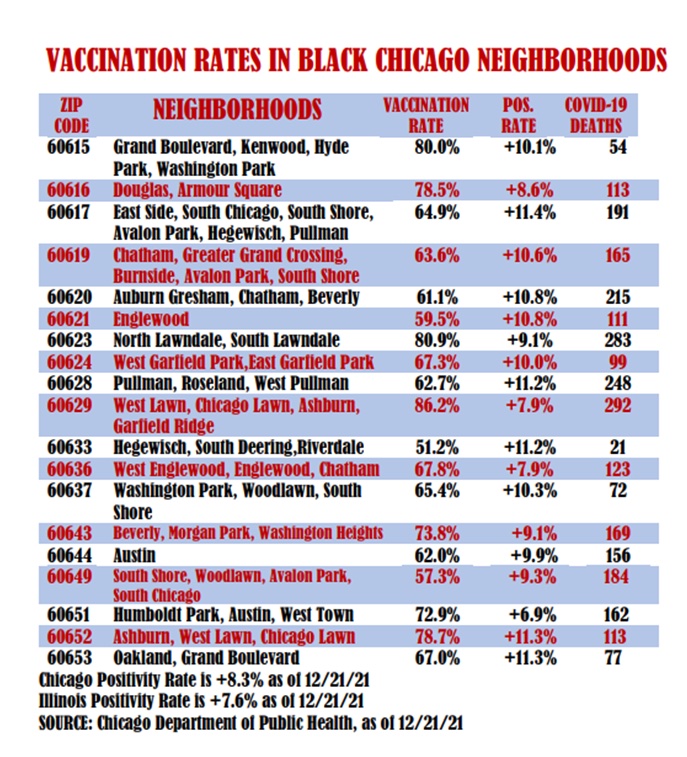The deadly holiday surge of COVID- 19 cases has pushed the positivity rate into double digits in 11 Black zip codes as rates in those zip codes soar well above the city and state averages, according to a Crusader analysis of data from the Chicago Department of Public Health on December 21.
Nearly 100 residents in Black neighborhoods have died of COVID-19 in just two weeks, the Crusader has learned.
The situation is worsening as the city implements new mandates for patrons of restaurants, gyms and businesses as the Omicron variant overtakes the Delta strain as the most dominant mutation ravaging cities across the country.
The city’s overall positivity rate on December 21 was 8.3 percent. That was higher than the state average of 7.6 percent. Sixteen Black zip codes had positivity rates higher than the city’s, and 18 Black zip codes had positivity rates higher than the state’s on December 21.
Perhaps the most disturbing data is the double-digit positivity rate in 11 Black zip codes on Chicago’s South Side.
On December 21, 11 Black zip codes had positivity rates above 11 percent, a disturbing sign that the coronavirus is spreading at an alarming rate. Last week, all of Chicago’s predominately Black zip codes had positivity rates in the single digits, but 13 zip codes had positivity rates higher than the city. On December 21 that number of zip codes had climbed to 16, and 18 Black zip codes had positivity rates higher than the state’s.
Among the 18 zip codes that had the highest double-digit positivity rates that are far above the city and state were 60617 (South Chicago, East Side), 60628 (Roseland, West Pullman), 60633 (Riverdale, Hegewisch), 60652 (Ashburn, West Lawn) and 60653 (Oakland, Grand Boulevard). The positivity rate in those zip codes on December 21 were at least 11 percent.
Zip code 60617 had the highest positivity rate with 11.4 percent of new COVID-19 cases in a rolling seven-day period. Zip code 60653, which includes Bronzeville’s Oakland and Grand Boulevard neighborhoods, had the second-highest positivity rate at 11.3 percent.
While indoor gatherings contribute to the rising positivity rate, health officials also say more COVID-19 testing among residents is also causing the positivity rate to climb. Many residents are getting tested before they hit the road and airports for the Christmas holiday.
But in Chicago’s Black neighborhoods, new COVID-19 cases are growing faster and killing residents at an alarming rate.
The Crusader found that 41 residents in Black neighborhoods died last week for a total of 91 deaths since December 6. That week, 50 people died in many zip codes that include predominantly Black neighborhoods on the South and West sides.
With two weeks left in December, the 91 deaths may grow beyond the 133 COVID-19 deaths among Chicago Blacks last January after the Christmas holiday surge in 2020.
In zip code 60615 (Grand Boulevard, Kenwood, Hyde Park, Washington Park), eight people died of COVID-19 in one week, according to calculations based on updated data from the Chicago Department of Health.
Meanwhile, residents on the South Side continue to participate in holiday gatherings. On Friday, December 17, the South Shore Chamber of Commerce held a free, big holiday party that included mingling, food, music and entertainment. A flier that was circulated in the community did not mention whether organizers would enforce the city’s mask mandate and implement COVID-19 protocols.
On December 21, Mayor Lori Lightfoot announced that the city will impose a wide-ranging vaccine mandate that will go into effect January 3.
Lightfoot explained the new requirements Tuesday were in response to the surge in COVID cases.
Proof of vaccination will be required at fitness gyms, restaurants, bars, entertainment venues where food and beverages are served, sports arenas, concert venues, bowling alleys and movie theaters. Grocery stores that have indoor dining sections are included in the mandate.
“These are the places that are the riskiest places for spread, which is why we’re focused on them,” Lightfoot said. “This order will remain in effect until the city deems that the threat of COVID-19 to public health has diminished significantly.”
“Chances are everyone knows someone with COVID-19 right now,” Chicago Department of Public Health Commissioner Dr. Allison Arwady said. “It’s everywhere.”
Restaurant owners are concerned the new mandate will make it difficult for their businesses as they continue to recover during the pandemic.
Following the announcement, the Illinois Restaurant Association released a statement that said, “Chicago’s hospitality community is in a very fragile stage of recovery. Throughout the pandemic, the industry has prioritized customer and team member safety above all else, and the IRA strongly supports vaccinations for everyone to mitigate the spread of COVID-19. We encourage all diners to please lend their cooperation, respect and kindness to the employees working to comply with the new mandate during these challenging times.”
The mandate does not affect churches.
Nearly two years after the pandemic began, some of Chicago’s Black churches are still closed for in-person worship, including Trinity United Church of Christ in Washington Heights, which offers online worship services.
Other Black churches remain open for in-person worship services with COVID-19 protocols in place.
In South Shore, Bryn Mawr Community Church, which reopened in July, enforces COVID-19 protocols that require congregants to wear masks. Singers without masks perform behind transparent shield guards, and many pews are blocked off to promote social distancing among worshippers.
In Woodlawn, a Facebook video of Sunday’s in-person worship service at Apostolic Church of God shows choir members spaced six feet apart. The singers do not have shield guards in front of them while singing, but they appear to perform at the back of the stage that is at least 30 feet from church-goers sitting in the pews.






